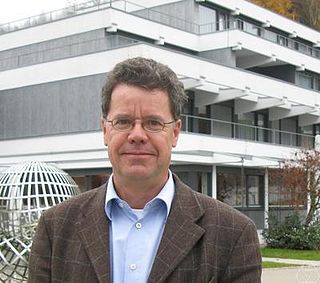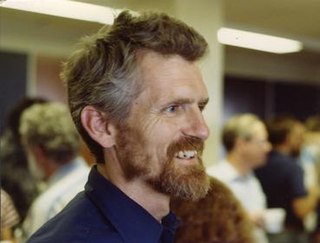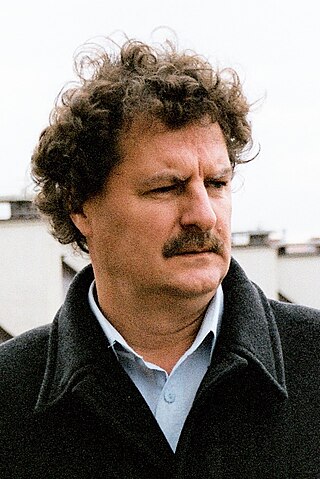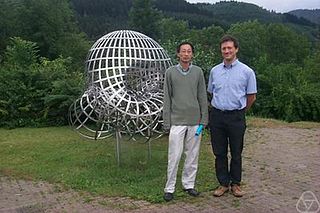In mathematics, a Lie algebroid is a vector bundle together with a Lie bracket on its space of sections and a vector bundle morphism , satisfying a Leibniz rule. A Lie algebroid can thus be thought of as a "many-object generalisation" of a Lie algebra.
In mathematics, a Lie groupoid is a groupoid where the set of objects and the set of morphisms are both manifolds, all the category operations are smooth, and the source and target operations
In differential geometry, a field in mathematics, a Poisson manifold is a smooth manifold endowed with a Poisson structure. The notion of Poisson manifold generalises that of symplectic manifold, which in turn generalises the phase space from Hamiltonian mechanics.
In mathematics, Floer homology is a tool for studying symplectic geometry and low-dimensional topology. Floer homology is a novel invariant that arises as an infinite-dimensional analogue of finite-dimensional Morse homology. Andreas Floer introduced the first version of Floer homology, now called Lagrangian Floer homology, in his proof of the Arnold conjecture in symplectic geometry. Floer also developed a closely related theory for Lagrangian submanifolds of a symplectic manifold. A third construction, also due to Floer, associates homology groups to closed three-dimensional manifolds using the Yang–Mills functional. These constructions and their descendants play a fundamental role in current investigations into the topology of symplectic and contact manifolds as well as (smooth) three- and four-dimensional manifolds.

Alan David Weinstein is a professor of mathematics at the University of California, Berkeley, working in the field of differential geometry, and especially in Poisson geometry.

André Joyal is a professor of mathematics at the Université du Québec à Montréal who works on category theory. He was a member of the School of Mathematics at the Institute for Advanced Study in 2013, where he was invited to join the Special Year on Univalent Foundations of Mathematics.
In the mathematics of Lie theory, Lie's third theorem states that every finite-dimensional Lie algebra over the real numbers is associated to a Lie group . The theorem is part of the Lie group–Lie algebra correspondence.
In mathematics, especially (higher) category theory, higher-dimensional algebra is the study of categorified structures. It has applications in nonabelian algebraic topology, and generalizes abstract algebra.

Izak (Ieke) Moerdijk is a Dutch mathematician, currently working at Utrecht University, who in 2012 won the Spinoza prize.
In mathematics, R-algebroids are constructed starting from groupoids. These are more abstract concepts than the Lie algebroids that play a similar role in the theory of Lie groupoids to that of Lie algebras in the theory of Lie groups..

Johannes Jisse (Hans) Duistermaat was a Dutch mathematician.
A Representation up to homotopy has several meanings. One of the earliest appeared in the `physical' context of constrained Hamiltonian systems. The essential idea is lifting a non-representation on a quotient to a representation up to strong homotopy on a resolution of the quotient. As a concept in differential geometry, it generalizes the notion of representation of a Lie algebra to Lie algebroids and nontrivial vector bundles. As such, it was introduced by Abad and Crainic.
A differentiable stack is the analogue in differential geometry of an algebraic stack in algebraic geometry. It can be described either as a stack over differentiable manifolds which admits an atlas, or as a Lie groupoid up to Morita equivalence.
This is a glossary of properties and concepts in symplectic geometry in mathematics. The terms listed here cover the occurrences of symplectic geometry both in topology as well as in algebraic geometry. The glossary also includes notions from Hamiltonian geometry, Poisson geometry and geometric quantization.

Janusz Roman Grabowski Polish mathematician working in differential geometry and mathematical methods in classical and quantum physics.

Rui António Loja Fernandes is a Portuguese mathematician working in the USA.
Charles-Michel Marle is a French engineer and mathematician, currently a Professor Emeritus at Pierre and Marie Curie University.
The André Lichnerowicz Prize for Poisson geometry is a mathematics distinction awarded since 2008 to reward notable contributions to Poisson geometry.

Giovanni Felder is a Swiss mathematical physicist and mathematician, working at ETH Zurich. He specializes in algebraic and geometric properties of integrable models of statistical mechanics and quantum field theory.

Alberto Sergio Cattaneo is an Italian mathematician and mathematical physicist, specializing in geometry related to quantum field theory and string theory.








